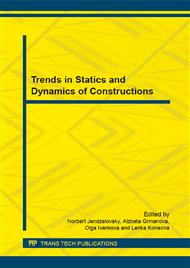[1]
J. Kralik, J. Kralik jr., Probability assessment of analysis of high-rise buildings seismic resistance, Advanced Materials Research, Volume 712-715, 2013, pp.929-936.
DOI: 10.4028/www.scientific.net/amr.712-715.929
Google Scholar
[2]
M. Krejsa, P. Janas, V. Krejsa, Software application of the DOProC method In: International Journal of Mathematics and Computers in Simulation Vol. 8, No. 1 (2014), pp.121-126 ISSN: 1998-0159.
Google Scholar
[3]
K. Kotrasova, Sloshing of Liquid in Rectangular Tank. In: Advanced Materials Research. No. 969 (2014), pp.320-323. - ISBN 978-303835147-4, ISSN 1662-8985.
DOI: 10.4028/www.scientific.net/amr.969.320
Google Scholar
[4]
K. Kotrasova, I. Grajciar, Dynamic Analysis of Liquid Storage Cylindrical Tanks Due to Earthquake. In: Advanced Materials Research. No. 969 (2014), pp.119-124. - ISBN 978-303835147-4, ISSN 1662-8985.
DOI: 10.4028/www.scientific.net/amr.969.119
Google Scholar
[5]
K. Kotrasova, I. Grajciar, E. Kormanikova, Dynamic Time-History Response of cylindrical tank considering fluid - structure interaction due to earthquake. Transport Structures and Wind Engineering. In: Applied Mechanics and Materials. No. 617 (2014).
DOI: 10.4028/www.scientific.net/amm.617.66
Google Scholar
[6]
H. Lamb, Hydrodynamics. 6th ed New York, Dover Publications, (1945).
Google Scholar
[7]
O. Sucharda, J. Brozovsky, Bearing capacity analysis of reinforced concrete beams, International Journal of Mechanics, Volume 7, Issue 3, 192-200, (2013).
Google Scholar
[8]
G. K. Batchelor, An introduction to fluid dynamics. Cambridge: Cambridge University Press. (1967).
Google Scholar
[9]
A. Di Carluccio, G. Fabbrocino, E. Salzano, G. Manfredi, Analysis of pressurized horizontal vessels under seismic excitation In: ICSV18: 18th The World Conference on Earthquake Engineering: October 12 – 17, 2008, Beijing, China.
Google Scholar
[10]
N. Jendzelovsky, L. Balaz, Numerical Modeling of Cylindrical Tank and Compare with Experiment. In: Applied Mechanics and Materials. ISSN 1660-9336. Vol. 617: 6th International Scientific Conference on Dynamic of Civil Engineering and Transport Structures and Wind Engineering, DYN-WIND 2014, Donovaly, SR, 25. -29. 5. 2014 (2014).
DOI: 10.4028/www.scientific.net/amm.617.148
Google Scholar
[11]
E. Kock, L. Olson, Fluid-structure interaction analysis by the finite element method a variational approach. International Journal for Numerical Methods in Engineering. Volume 31, Issue 3, pp.463-491, March 1991, John Wiley & Sons, Ltd.
DOI: 10.1002/nme.1620310305
Google Scholar
[12]
B. Taraba, Z. Michalec, V. Michalcova, T. Blejchar, M. Bojko, M. Kozubkova, CFD simulations of the effect of wind on the spontaneous heating of coal stockpiles. Fuel, 2014, vol. 118, pp.107-112.
DOI: 10.1016/j.fuel.2013.10.064
Google Scholar
[13]
M. Zmindak, I. Grajciar, Simulation of the aquaplane problem. Computers and Structures. Vol. 64, Issue 5-6, September 1997, pp.1155-1164.
DOI: 10.1016/s0045-7949(97)00024-2
Google Scholar
[14]
Manual ADINA. 71 Elton Ave, Watertown, MA 02472, USA, ADINA R&D, Inc., Oct. (2005).
Google Scholar
[15]
L. Meirovitch, Computational Methods in Structural Dynamics. Sijthoff & Noordhoff, 1980. Netherlands.
Google Scholar
[16]
J. Melcer, Experimental testing of a bridge. Applied Mechanics and Materials, Volume 486, 2014, pp.333-340.
Google Scholar


